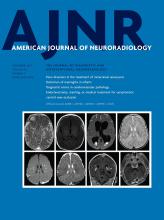We read with interest the article by Li et al, “Brain Perfusion Alterations on 3D Pseudocontinuous Arterial Spin-Labe-ling MR Imaging in Patients with Autoimmune Encephalitis: A Case Series and Literature Review,” recently published in the American Journal of Neuroradiology. In this retrospective case series, the authors found that all patients with autoimmune encephalitis (AE) had increased CBF in the inflammatory area.1 Indeed, arterial spin-labeling (ASL) is critical in the diagnosis of AE and may serve as early evidence preceding conventional abnormal findings on MR imaging and laboratory diagnosis. Sachs et al2 found cerebral hyperperfusion in anti-N-methyl-D-aspartate (NMDAR) encephalitis. Vallabhaneni et al3 demonstrated incre-ased CBF and CBV in the left parieto-occipital gray matter on CT perfusion. Sarria-Estrada et al4 revealed ASL hyperperfusion overlapping the involved lesions, but they also found increased perfusion and increased metabolism on [18F] FDG-PET/CT and SPECT in paraneoplastic autoimmune encephalitis.
As mentioned above,4 we have also encountered several cases of AE with hypoperfusion or without any visible changes on ASL perfusion in clinical practice. We retrospectively reviewed image data from 30 consecutive patients with AE in the most recent 2 years including major constituents of AE-covered anti-NMDAR (11 patients), anti-leucine-rich glioma inactivated-1 (5 patients), anti-G-protein coupled receptor for gamma-aminobutyric acid receptor (4 patients), anti-myelin oligodendrocyte glycoprotein antibody associated encephalitis (3 patients), anti-contactin-associated protein-like 2 antibody-associated disease (3 patients), Hashimoto encephalopathy (2 patients), anti-glutamic acid decarboxylase-65 AE (1 patient), and anti-CV2 AE (1 patient). All MR imaging of our patients was also performed on a 3T MR imaging scanner (Discovery 750; GE Healthcare) with a 3D ASL sequence. Seven patients had visible infected lesions with increased perfusion on ASL, 5 patients showed asymmetric changes across brain regions without intracranial lesions on T2 FLAIR, and 2 patients presented with decreased perfusion with visible infected focus, while the rest of the patients presented with normal perfusion without intracranial lesions.
Comparing the findings of Li et al,1 we wondered why our hospitalized patients with AE failed to show a high proportion of hyperperfusion changes on ASL. We reviewed the published CBF studies evaluated using 3D ASL perfusion imaging in patients with AE and found that brain MR imaging revealed no morphologic abnormalities in patients with anti-NMDAR AE, but 3D ASL perfusion imaging showed reduced CBF in the special brain regions, including the left frontal and temporal regions and the right cerebellum.5 Li et al6 also found hyperintensities in the bilateral hippocampus on MR imaging for patients with anti-LGI 1 AE, but no abnormal perfusion/metabolism on ASL and [18F] FDG-PET/CT.
Different from the higher CBF in patients with herpes simplex encephalitis at the acute stage,7 AE is one of the emergent causes of subacute changes caused by antibodies. CSF analysis and MR imaging could reveal inflammatory changes. However, less than half of the cases of AE showed any abnormal findings on brain MR imaging,3 which is also consistent with our findings. ASL hyperperfusion of the affected brain regions in AE may be due to either a seizure-related outcome or active inflammation of the brain involved. Kumar et al8 found MR imaging changes (9 patients included) in Rasmussen encephalitis on conventional MR imaging (without atrophy), corresponding to regional hyperperfusion in 7 patients on ASL, and they also found ASL hypoperfusion in 2 patients, who had respective volume loss on MR imaging.8 Most cogently, 5 patients showed a concordance between ASL hyperperfusion and the clinical ictal onset zone.
Another very interesting finding was that several cases with ASL hyperperfusion were concordant with the interictal epileptiform discharges (7 patients) and the electroencephalogram ictal onset zone (6 patients).8 This finding can be confirmed in the other studies as well. Despite normal MR imaging findings, reversible mixed perfusion on iodine 123 (123I-IMP) SPECT was found in patients with anti-alpha-amino-3-hydroxy-5-methyl-4-isoxazolepropionic acid (AMPA) receptor encephalitis and anti-gamma-aminobutyric acid B (GABAB) receptor encephalitis,9,10 in which the first SPECT revealed hypoperfusion of the limbic system and cerebellum. These areas often contain high levels of GABAB receptors. Meanwhile, hyperperfusion in the motor strip and left temporal lobe was consistent with some of the patients’ symptoms, like seizures. In view of our cases, some patients with hyperperfusion may be in status epilepticus or an acute stage of the disease, while normal perfusion or hypoperfusion may be due to their invisible abnormal findings on brain MR imaging or subclinical and chronic phases. Of course, susceptibility artifacts are unavoidable and should be excluded in cases with misrepresentation of brain MR imaging. Our findings need to be confirmed by a larger sample size and electrophysiology in the future.
In conclusion, 3D pseudocontinuous arterial spin-labeling may have added value in the early diagnosis and assessment of the therapeutic effects in AE. ASL not only presented hyperperfusion changes, but also showed no perfusion changes or hypoperfusion at different stages of the disease.
Footnotes
Disclosure forms provided by the authors are available with the full text and PDF of this article at www.ajnr.org.
References
- © 2022 by American Journal of Neuroradiology












